
Banner
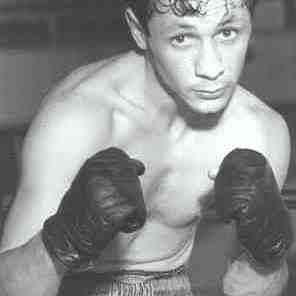
Zion Mule Corps, Fusiliers & the Great Boxing Contest
Published
9 years agoon
By
adminMIKE MEYERSON
Introduction and all pictures sourced by ANT KATZ
The historical relationship between Australia and Israel was forged in the heat of battle during WWI. Members of Zion Mule Corps served alongside Anzac troops on the shores of Gallipoli. The corps, largely made up of Jewish volunteers, recognised the importance of fighting with the Allies and the values they stood for. This relationship strengthened as members of the Australian Light Horse Brigade strove gallantly through the Turkish Ottoman trenches in the city of Be’er Sheva. Fighting for freedom of the land, the soldiers were welcomed into the homes and hearts of Jewish residents.
Australia went on to acknowledge and appreciate their role at the time of the re-establishment of the modern state of Israel. Australia courageously assisted in securing the UN decision in November 1947 and was the first to vote in favour of the establishment of Israel in May 1948. The country also sponsored the resolution for Israel’s admittance to the UN in 1949.
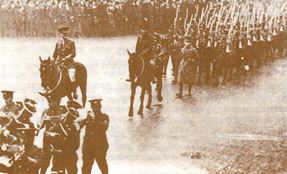
RIGHT: The first Jewish fighting unit since the destruction of the Temple in Jerusalem in the ninth century marched through the streets of London in 1917.
After years of campaigning for a Jewish combat unit, the Jewish battalions were formed following the successful service of a Zion Mule Corps in Gallipoli in 1915. Officially, they were the 38th, 39th and 40th Battalions of the Royal Fusiliers, with the 41st and 42nd as their reserves.
After the war, In late 1919, the Jewish Legion was reduced to one battalion titled First Judaeans, and awarded a distinctive cap, badge, a menorah with the Hebrew word “קדימה” Kadima (forward) at the base.
STORY CONTINUES BELOW PICTURE
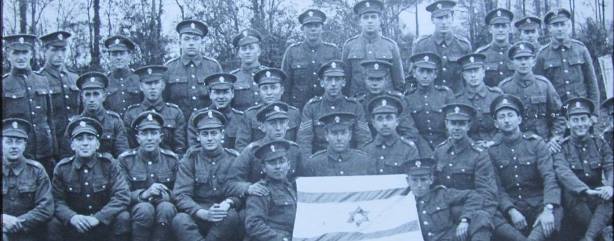
ABOVE: The first wave of Jewish soldiers were East-Londoners, pictured here before departing to the holy land.
Former members of the Legion took part in the defence of Jewish communities during the Riots in Palestine of 1920, which resulted in the arrest of Jabotinsky. Two former members of the Legion were killed with Trumpeldor at Tel Hai. One former member of the Legion was killed in Tel Aviv-Jaffa during the Jaffa riots of 1921.
The Zion Mule Corps, The Fusiliers & the Great Boxing Competition
It would come as a surprise to many Australians to hear that the Australian Imperial forces were not the only forces in the First World War to be composed entirely of volunteers. There was another army which was comprised entirely of volunteer troops. These troops, all Jewish, first saw action in Gallipoli, in a unit called The Zion Mule Corps (ZMC).
 Many of the “muleteers” felt insulted when they were first informed of the nature of their work, as they considered it demeaning to be allocated to a “donkey” corps by the British and contemplated withdrawing their services.
Many of the “muleteers” felt insulted when they were first informed of the nature of their work, as they considered it demeaning to be allocated to a “donkey” corps by the British and contemplated withdrawing their services.
RIGHT: A young David Ben-Gurion in his “First Judaean”uniform
They were persuaded to enlist, however, by Joseph Trumpeldor. Trumpeldor had already proved himself a hero while fighting for Russia in the Russo-Japanese conflict.
His gallantry in the defence of Port Arthur was of such magnitude that, despite being Jewish, he was awarded the Cross of St George, the Russian equivalent of the VC, and made an officer. This was a huge achievement for a Jewish soldier in Russia, which had the most brutal institutionalised anti-Semitism. In the 19th century, under Nicholas 1, all Jewish males between the ages of 12 and 25 were conscripted into the Russian army for 25 years.
Between 1910 & 1940, 26 Jewish boxers
held the title of World Boxing Champion
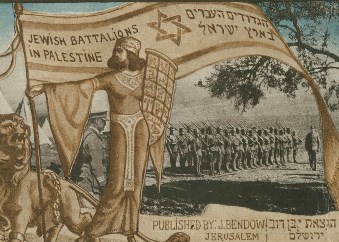
LEFT: Poster of the Jewish Legion, a military formation of Jewish volunteers who fought with the British Army during the First World War
Trumpeldor was made second in command of the ZMC but later took over from the commanding officer, Col John Patterson, a 47-year-old Irish protestant and a veteran of the Boer War. The muleteers were assigned the least glamorous but also extremely dangerous task of transporting supplies under fire from the landing craft to the troops dug into the trenches. They were issued with rifles and did come to see active combat, although unofficially, at Gallipoli.
The Inniskilling Fusiliers in particular were grateful to receive their active support in the assault on Achi Baba. The muleteers were lauded by General Hamilton, who in a letter to General Maxwell on May 4 1915, remarked: “What we would have done without the Zion Mule Corps I do not know.” Hamilton was also recorded as writing: “The men have done extremely well, working their mules calmly under heavy shell and rifle fire, and thus showing a more difficult type of bravery than the men in the front line…“.
These comments are praise indeed from this man, who besides his well-known ineptitude as a military commander, was also a bigot, with a habit of making puerile anti-Semitic asides.
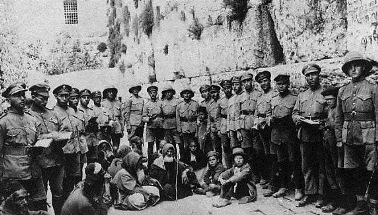
LEFT: Jewish Legion soldiers at the Western Wall after taking part in 1917 British conquest of Jerusalem
The ZMC was disbanded following the defeat of the Allies at Gallipoli but reformed as The Royal Fusiliers (38th-42nd battalions) also known as The Jewish Legion to serve actively in Palestine. The history of the ZMC and The Jewish Legion has been poorly documented in standard texts, only occasionally receiving a mention not exceeding a line or two. In contrast the feats of Simpson and his donkey have been immortalised in history and in bronze outside the Australian War Museum in Canberra. (Donkeys and Mules on Gallipoli, 1915, Tony James).
The exploits of the ZMC and The Jewish Legion have, however, been well documented by Colonel Patterson, in his books “With the Zionists in Gallipoli” and “With the Judeans in the Palestine Campaign”, and also by Martin Watts in his comprehensive work, “The Jewish Legion and the First World War”. Patterson wrote largely with the intention of exposing the poor treatment the British gave these soldiers on account of their religion but also to record the considerable contribution these troops made in action against the Turks.
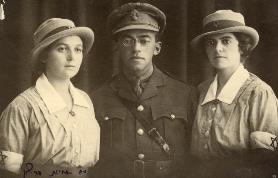
RIGHT: Ze’ev Jabotinsky wearing the uniform of the Jewish Legion of the British army, with his two sisters Bela and Nina
They were, in effect, fighting on two fronts. Patterson, a man committed to honesty and justice, was overcome by shame at the maltreatment his men suffered at the hands of the bigoted British officers. This probably accounts for his stated decision to leave out many of the details of this anti-Semitism, despite feeling that the treatment meted out by members of The Expeditionary Force would have left “an indelible mark in the mind and heart of every man who served in the Jewish battalion”.
My intention, too, is not to dwell on the hardships these men suffered but to relate a strange event which I have not found anywhere but in Patterson’s account of it in “With the Judeans in the Palestine Campaign”. This was the “The Great Boxing Tournament”, which was held at the conclusion of hostilities.
‘The Palestine championships’
During the period of demobilisation there was a need to keep the troops occupied in the weeks before they returned to their home countries. For this purpose a number of sporting competitions were organised by General Headquarters in Palestine.
It was, however, the boxing competition – “The Palestine Championships”, in which all the Allied troops in Palestine competed – that attracted the most interest.
Teams were chosen from brigades or divisions but as the Jewish Fusiliers constituted neither a brigade nor a division their team had to be chosen from a battalion. Patterson regarded this as a considerable handicap because a battalion consists of 1 000 men, whereas a brigade consists of three to four thousand men and a division consists of twelve to twenty thousand men.
He nevertheless hoped that providing the members of his team were adequately trained they would be able to at least hold their own against those representing brigades or divisions. His main concern was that his men should compete and not be humiliated. Patterson therefore arranged for his boxing team to be sent to El Arish, 30 miles away, to be “licked into condition” by Sergeant Goldberg, a boxing instructor.
The contest was arranged so that there were four preliminary tournaments, comprising a tournament each for the troops in Egypt, Palestine and Syria with a fourth tournament between the Australians and the New Zealanders. The winners of these tournaments were to compete in the finals in Cairo.
The Fusiliers competed in the Palestine competition, held at Kantara, in front of thousands of spectators. Patterson’s team to everyone’s surprise won this regional contest, defeating allcomers. The victors were: Private Burack (Heavyweight), Private Tankinoff (Welterweight), Private Cohen (Lightweight), Private Franks (Featherweight), and Private Goldfarb (Bantamweight).
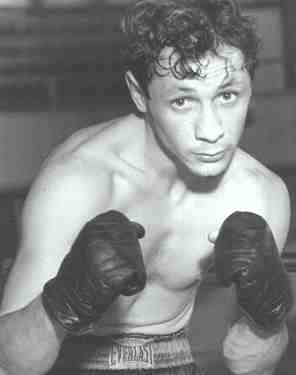
LEFT: Boxer Benny Goldberg was a tough Bantamweight contender, originally fighting out of Detroit, Michigan before moving to Los Angeles in 1944
Patterson was elated at the outcome and presented a gold medal to each of the winners. He had possibly been more upset by the poor treatment of his men than the men themselves, and unable to contain his emotions remarked: “The first round of this essentially British form of sport was fought and won by the despised Jewish Battalion!”
He asked whether anything could be more fitting. The Fusiliers had now qualified to box in Cairo for the Championship of the Egyptian Expeditionary Forces (EEF) where they were to compete against the champions of Egypt, Syria and the Australian forces.
The Jewish Battalion continued their winning streak, defeating – incredibly – all the British regiments winning nearly every match. They eventually qualified to compete in the finals against the formidable Australians. One can only imagine the trepidation that the men boxing for the Fusiliers must have felt before the final against the Australian team – a team chosen from the large Australian force, which had the well-earned reputation of possessing some of the most courageous soldiers in the Allied forces.
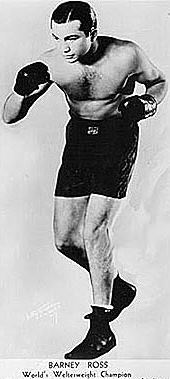
RIGHT: Barney Ross was a hero in and out of the ring
It was also likely that the soldiers chosen to represent Australia would have had prior ring experience. Only a boxer himself can appreciate what goes through the mind of a man about to enter the ring, knowing that, win, draw or lose, the encounter will generally result in two battered, bruised and sometimes bloodied bodies.
Cus D’Amato, the legendary boxing trainer, summed up the feelings of a boxer as he climbs through the ropes, “so now they get into the ring… The other guy probably looks bigger and stronger and better conditioned and real muscular and when he starts to loosen up he looks more experienced.
“This is the novice fighter’s mind and imagination exaggerating everything, which is what the mind does. Nothing is ever as bad as the imagination makes it, not even death”.
The Fusiliers may, however, have taken comfort in knowing that they had already survived deadly encounters with the Turks in battle. Enclosed in a ring, insulated from the vilification of the British, and having to deal with only one opponent, who is only allowed to punch with padded fists, under the supervision of a referee, may have seemed to them a comparatively safe place to be!
We will never know what went through the minds of these men, but we do know that the night of the finals was described as one of magnificent boxing. The contest between the Jewish Fusiliers and the mighty Australians eventually concluded not with the expected routing of the Fusiliers but – to the astonishment of all – in a draw.
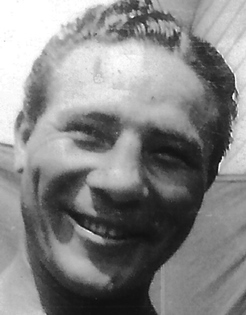
LEFT: Heavyweight Champion of the World in the 1930s, US boxer Max Baer, rated #22 on Ring Magazine’s 100 greatest punchers of all time, had a brother, Buddy, who was also a heavyweight contender
This outcome was perhaps fitting, not only because it was a contest fought between the only two forces in the war that were comprised entirely of volunteer soldiers, but because the Jewish Legion and the Anzacs had become intertwined in their battles against the Turks.
The 39th regiment (Jewish Legion) was under the command of the naturalised Jewish Australian, Colonel Eliazar Margolin. Margolin had served under Monash commanding the 16th battalion at Gallipoli and was in charge of the last group of Allied forces to leave Gallipoli. He played an important part in helping to manage the only successful element of the Gallipoli campaign – the evacuation. Margolin’s career was later sullied by having to endure the humiliation of being maligned by a dishonest bigot in the Australian parliament.
Jewish Legion was also at one stage attached to Major-General Edward Chaytor, a New Zealander who had commanded the renowned Anzac Mounted Division. Chaytor, after presenting decorations to the men of the Legion for gallantry under his command, said in his address how he was particularly struck with their good work on the Mellahah front, by their gallant capture of the Umm esh Shert Ford and their defeat of the Turkish rear guard.
He stressed that it was these actions that enabled him to push his mounted men over the Jordan and in this way The Jewish Legion had contributed materially to the capture of Es Salt and Amman, the cutting of the Hedjaz Railway and the destruction of the 4th Turkish Army.
We were robbed!
Sadly, the result of the boxing finals although a draw, was not declared a draw. The Australians were announced as the winners. The shameful and absurd reason given for this decision was that there was no officer in the team of the Jewish Battalion.
This claim itself was not true. An officer was a member of the team but the judge declared that the officer was only “attached” to the 38th for duty and therefore could not be claimed as belonging to the Battalion. Patterson was greatly offended by the dishonest manipulation of the result. He took care to mention in his account that the judge was a British general adding for emphasis “not an Australian” – the implication being that an Australian would not have engaged in such a deplorable show of bad sportsmanship.
The matter was, however, not so straightforward for the fair-minded Patterson, because Patterson was himself, conflicted by the outcome. While objectively offended by the dishonesty of the judging, Patterson was nevertheless uncomfortable with the outcome being declared a draw, and he was even more ill at ease with the prospect of the Jewish team being declared the winners.
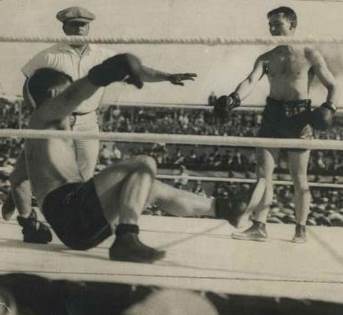
RIGHT: July 4 1922: Benny Leonard downs Rocky Kansas
Patterson was unable to escape his upbringing, and while seemingly outraged at the decision, rationalised the situation thus: “I suppose it really would not have been the ‘right thing’ for a Jewish Battalion to have defeated the whole of the Egyptian Expeditionary Force!”
Interestingly, Issy Smith (Shmeilowitz), a naturalised Australian, won the British Army’s middleweight boxing championship and was subsequently awarded the VC for gallantry in 1915 while serving in the 1st Manchester regiment during the second battle of Ypres.
What would Patterson have thought if he could have known that the domination of world boxing by Jewish fighters had already begun and was set to continue until the next World War?
Many of these boxing champions came from Jewish stock that fled to America in order to escape the tyranny of the Tsarist regime and were therefore from backgrounds similar to many of the men who made up Patterson’s original ZMC. Between 1910 and 1940 there were 26 Jewish boxers who held the title of world boxing champion. (When boxing was a Jewish sport, Allen Bodner).
This number is made more impressive when one considers that in those days there was only one world champion in each division because the multiple sanctioning bodies of today did not exist in those times.
World champions such as Barney Ross, Benny Leonard (lightweight champion from 1917 to 1925), Maxie Rosenbloom (world heavyweight champion), Battling Levinsky (light-heavyweight king from 1926-1920), “kid” Kaplan, Lew Tendler, and Jackie “Kid” Berg are among the 11 Jewish boxers immortalised in the Boxing Hall of Fame.
We can only wonder if Patterson would have considered it not the “right thing” for these Jewish boxers to have achieved such success.
It was, however, not only in boxing that the Jewish Battalion made its mark in the post war competitions. In football they were the runners-up for the Championship of Palestine and in cricket they defeated all-comers with the exception of the Flying Corps. They even won the baseball tournament courtesy of the Americans among their numbers.
They excelled, again, in the Concert section easily taking first place. In this event there is no record of the British masters being perturbed that the Jewish Battalion should take the honours. Patterson maintained that he had only to put out word that Tchaikov –the first violinist – was to perform, in order to draw a crowd large enough to pack out the concert tent four times over.
Patterson’s first-hand description of the Great Boxing Tournament is just one minor example of the bigotry and duplicitous behaviour of the British Officer Class in the First World War. Blinded by bigotry, the British officer class would not have recognised the irony in vilifying a minority group, such as the Jewish volunteers, while lionising great individual Jewish soldiers such as Sir General John Monash, and those awarded the VC.
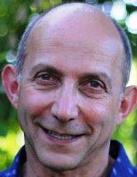 Sadly, Watt concluded in his book on The Jewish Legion that post-war anti-Semitism in Britain paid little heed to Jewish war service. The same rule seems to apply to all minorities who in times of war so readily join forces with those who vilify them. The Australian aboriginals are a perfect example.
Sadly, Watt concluded in his book on The Jewish Legion that post-war anti-Semitism in Britain paid little heed to Jewish war service. The same rule seems to apply to all minorities who in times of war so readily join forces with those who vilify them. The Australian aboriginals are a perfect example.
PICTURED RIGHT: Aussie expat and regular Jewish Report Online reader Mike Meyerson has shared two other very well-read pieces recently. Check them out:





Samuel Goldberg
Jun 11, 2016 at 4:17 pm
‘So proud to see my dear dad Bennie Goldberg, one of the Jewish boxers immortalised in the Boxing Hall of Fame. On behalf of my dad thank you so much for your kind words and wonderful historical review of these brave and wonderful jewish hero’s who did so much to inspire not only the jewish communities, but all those who fought the good fight on behalf of all of us. God bless you and yours. Sammy Goldberg, proud son of Bennie Goldberg
‘